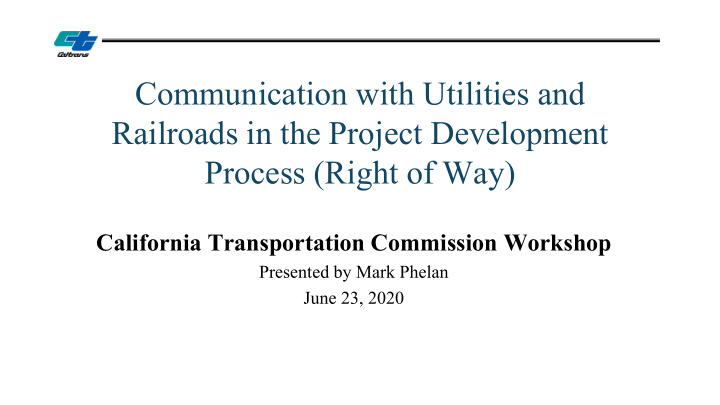



Communication with Utilities and Railroads in the Project Development Process (Right of Way) California Transportation Commission Workshop Presented by Mark Phelan June 23, 2020
Primary Utility and Railroad Companies Utility Companies Railroads Dozens of other additional Utilities and Regional Transit Operators 2
Caltrans Project Development Process PS&E Construction Need & (Design ) PID PA&ED Priority Identified Right of Way 3
Project Initiation – First Identification and Contact PS&E Construction Need & (Design ) PID PA&ED Priority Identified Right of Way PID: Occasional Early Coordination (informal) - Potential conflicts noted in the Project Initiation Document - Conceptual cost estimate prepared based on historic data - Identify potential utility/RR agreements to plan schedule - Very little contact at this stage with externals
Utility and Railroad Coordination – PA&ED PS&E Construction Need & (Design ) PID PA&ED Priority Identified Right of Way PA&ED – Standard Early Coordination (informal) - Conflicts are identified in more detail - Begin consultation with Utility companies - Send plans to utilities and request verification maps - Identify required railroad agreements
Utility and Railroad Coordination – PS&E & R/W PS&E Construction Need & (Design ) PID PA&ED Priority Identified Right of Way Right of Way and PS&E phases are concurrent - Identify replacement property rights as necessary - Finalize Utility agreements, request and approve relocation plans and provide Notices to Owner - Execute final agreements with Railroads
Utility and Railroad Coordination – Construction PS&E Construction Need & (Design ) PID PA&ED Priority Identified Right of Way - Monitor Utility relocations, pay utility and railroad invoices - Prepare and record conveyance documents - Monitor RR and Utility agreements for schedule tracking and funding balances - Close out and final accounting
Challenges Caltrans: Utilities and Railroads • Independent offices/lack of • - Scope changes corporate direction – Agreement revision due to changing impact areas • Staff turnover – “Re-starting the clock” due to • Disagreement on prior rights revisions and liability for relocation – Staff turnover and lack of • Conflicting work of a higher expertise priority (emergency repairs, • Lack of leverage fires, etc.) • Lack of quality as-built maps • No Caltrans priority with major rail carriers (UP, BNSF)
Mitigation Strategies • Engage utilities and railroads during PID review • Improved mapping earlier in PA/ED phase • Minimize scope changes during project development • Identify conflict risks and risk management • Project Team understanding of Utility and RR schedules • Engage with utility management – identify focal points with partners • Quarterly status meetings with utilities and railroads 9
Questions?
Communication with External Agencies in the Project Development Process (Environmental) California Transportation Commission Workshop Presented by Kirsten Helton June 23, 2020
Agencies and Requirements Increasing Project Delivery Requirements (Pre- 1940 to Present) 200 108 102 91 81 Number of 70 54 25 Laws 0 To 1970 To 1980 To 1990 To 2000 To 2010 To 2015 To Present =Environmental Laws, Regulations and Orders 12
How Agencies Issue Permits Agencies adopt Caltrans Environmental Documents to issue permits 13
Agency Coordination - PID Project Initiation Document PID: Occasional Early Coordination (informal) - For only most complex projects - Survey methodologies - Agency concerns - Early concurrence on process - All at a very conceptual level 14
Agency Coordination – PA&ED Project Approval & Environmental Document PA&ED – Standard Early Coordination (informal) - Proposed project alternatives - Survey methodologies/Areas of project impact - Agency concerns - Concurrence on process - Still fairly conceptual 15
Agency Coordination – PS&E Project Specifications & Estimates PS&E – Permitting Process (formal) - Survey results - Areas of Project Impact – Quantified - Mitigation proposals - Concurrence on impacts/project actions/mitigation - Narrow time frame - All permits needed for RTL 16
Challenges Caltrans: Agencies: • Lack of time/resources in • Autonomous regions/field PID offices can affect consistency • Design timing • Complex approval process – Failure to prioritize environmental considerations in Design – Delegation of signature authority – Late involvement of DES (Bridges) broached in AB1282 – Permit revision due to changing • Differing opinions on extent impact areas of jurisdiction and • No time for negotiation of mitigation permit conditions in schedule 17
AB 1282 Recommendations Offer Solutions Establishes the Transportation Permitting Task Force Statutory Goals: • Early engagement • Reasonable deadlines • Greater certainty of permit approval requirements 18
Questions?
Recommend
More recommend